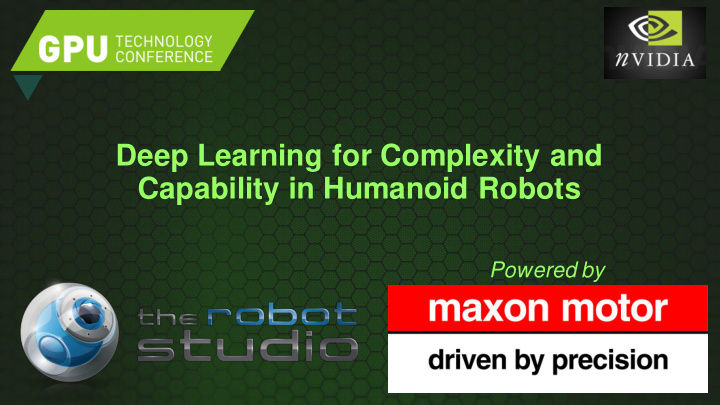



Deep Learning for Complexity and Capability in Humanoid Robots Powered by
Welcome Overview of the particular type of robot we manufacture An “ Anthropomimetic ” robot Place it within the range of humanoid robot technologies Challenges and opportunities abound Make some predictions as to how robots may develop The rise of smart robots Present our thoughts on embedded AI systems Q&A
Open Source Android Our robot is the humanoid with a single green eye Aims to copy the anatomy of the real human body The “ anthropomimetic ” approach Developed a series of robot prototypes over the last 10 years Anatomical input from medical, sports training and plastinations
CRONOS – a conscious robot Original reason to create these robots was to investigate consciousness Funded by the EPSRC Adventure Fund Theory is to shape the sensation of existence with the form of the body Make a robot as much like the human body as possible Synthetic Methodology Embedded Intelligence HAL is impossible
The Anthropomimetic Approach Endoskeleton actuated by tendons Electric motors spool tendons 3D joints are true ball and socket Attachment points match the real muscles Muscle does a lot more than just contract Compliant structure Tendons are elastic Antagonistic set-up
Unexpectedly likeable robot Despite looking like a skinned body • people loved the robot
Control We were not constrained by having to actually make the robot do any particular task The point of ECCE was to address “Emerging Cognition” Had to build a structure that can be controlled All complex animals solve this problem Doesn’t seem like a good idea to an engineer Appropriate for copying the human body “Not an engineered system!” Needs a self-learning control system
Robots with real capability Lots of robots have come and gone End up abandoned in the corner World’s most popular robot is R2 -D2 Not C3-PO – function is more important than form General Purpose Power Tool From the POV of the user the task is completed in its entirety Not an appliance Extremely high expectations – oldest anticipated invention
Technologies in humanoid robots A spectrum defined by how hard they are to control Depends on mechanical design approach Classical Familiar and well understood – factory robots Compliant Series-elastic actuation – factory robots with suspension Bio-inspired Compliant, tendon-driven, antagonistic
Classical robots – Common in industry Mechanical design maximises stiffness Very precise control Continuous maximum power Usually fixed base Highly dangerous Contact with people heavily restricted by safety legislation Ultimate example ASIMO Requires precise conditions to operate
ASIMO ASIMO Cart bot video Mobile phone catch
Compliant robots – Series Elastic Mechanical design maximises efficiency Precise control is difficult Peak power output considerably higher than average Well suited to legged robots Generally safer Governed by difference legislation Best examples produced by Boston Dynamics SPOT Mini is the most important
Compliant robots Spot video Flip video
Bio-inspired robots – ballistic tendons Mechanical design reproduces organic system Any control is difficult Ballistic speeds and power are possible Best design for legged robots Accidental high impacts rare but possible Governed by compliant legislation Most complete examples ourselves and Kijiro
Ballistic robots Video ball throw Video jumping robot
Future direction Must be compliant Real compliance, not active Tendons as appropriate Hybrid design to save cost and complexity Tremendous amount of work to do in control High level – vision, navigation, decision making, etc Low level – , basic co-ordination, physics modelling, etc Are GPU’s the answer?
Complexity and capability By definition a general purpose robot cannot be simplified Complexity at three levels: Mechanics, Electrical and Computational Dependency Principle The interaction of three domains makes debugging very challenging Lack of abstraction makes it hard to divide work Gestalt entity Really don’t know what you have until it’s finished When initial assumptions revisited you know you’re getting close Useful also means powerful enough to be dangerous
Practical solutions Convergence of culture and technology inevitable Two approaches evident: 1. End-to-end development – Centralised resources e.g. Softbank 2. Open Source movement – Distributed effort, worked for drones Parallels to iPhone and android, Mac and PC Component level manufacturing remains black-box We’re looking for collaborators to move up to the next step Enough reliable robots to generate the data for control
Problem We want the robots to perform tasks well in our environment, be safe and robust . Complexity of the robot: non-linearity , elasticity , compliance. Unpredictable environment, always changing. => not possible to program by hand The robot has to learn skills by itself Tools available for that : Reinforcement Learning
Applying RL on hardware directly Takes a long time to get results Requires many robots to learn faster In many cases, it would damage itself or the environment Needs of maintenance and human supervision ➢ Cost a lot of money Not efficient! We need to simulate the robot and apply RL in a simulation, then transfer the skill to the robot.
Procedure and progress ✓ Build the robot ✓ Getting actuators and sensors working ➢ Simulation of the robot Training of DRL in the cloud in a parallel simulators, on a server with GPUs Knowledge transfer to the real robot. Running inferences locally on a Jetson TX2
Jetson TX2 – a game changer Credit card size footprint 1TFLOPS with GPU Run inferences in embedded systems 2 CAN bus Direct connexion with motor controllers, no need of extra micro- controller hardware.
Technology convergence
Reinforcement Learning Blender + molecular add-on + python scripting + tensorflow
Deep Reinforcement Learning Combining DL and RL Example: The agent input observation from the environment is camera images on which DL with CNN can be applied.
Challenge Model the physics of series-elastic actuators Blender + python scripting Bullet API OpenSim Simulators ROS rviz – too limited in terms of physics Gazebo – too limited in terms of graphics Model photo-realistic environment Unreal Engine 4 ISSAC Initiative
Thank you! Any questions ? Contacts : Rob Knight rob.knight@therobotstudio.com • Cyril Jourdan cyril.jourdan@therobotstudio.com Website : www.therobotstudio.com
Recommend
More recommend